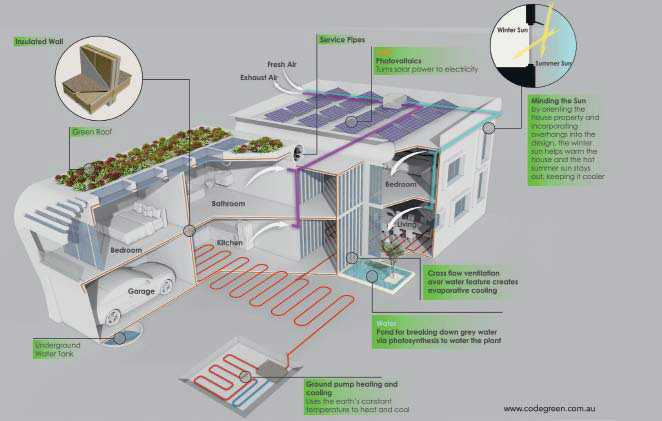PASSIVE HOUSE
.
Published in: GRAND DESIGNS // EXPERT ADVICE // building
Employing design principles for the house of the future
Today, terms such as eco and sustainable are being used to describe houses where thermal performance and effects on the natural environment have been taken into consideration. Now a new term is being used to define these — passive house — and although it appears to be relatively new here in Australia, Passive house has been used in Europe for many years. A passive house will have the following attributes:
- It will be well insulated
- Contain high-performance glazing
- Require little energy to make the house comfortable year-round
- Will not require mechanical heating and cooling systems
- All gaps around all window and door openings will be completely sealed.
Not just any house can be called a passive house — certain criteria with set parameters have to be met:
- Thermal comfort
- Airtightness
- Energy demand
- Space heating demand
- Space cooling demand.
Thermal comfort is defined as “the condition of the mind that expresses satisfaction with the thermal environment and is assessed by subjective evaluation”. To conform with the criteria, thermal comfort must be met for all living areas all year round, with temperatures to not exceed 25°Celsius for not more than 10 per cent of the hours within any given year.
Airtightness is defined as “the resistance to inward or outward air leakage through unintentional leakage points or areas in the building envelope”. All gaps around windows, doors, floors and roofs have to be completely sealed to stop leakage. Houses will be pressure tested to identify any leakage points, so they can be sealed. A ventilation system will need to be installed and will supply continuous fresh air, creating superior air quality with no draughts. A highly efficient heat recovery unit should also be installed. This extracts and re-uses the heat contained in the air within the roof space as well as exhaust from the bathrooms.
Energy demand “determines the impact on the environment from non-renewable energy sources that are supplied to the building”. The energy usage must not exceed 120kW annually for domestic applications per square metre of usable living space. This includes cooling, heating, hot water and domestic electricity.
Space heating demand is calculated by dividing up a year’s worth of space heating energy consumption by the measured floor area of your house. This must not to exceed 15kW annually per square metre of the usable living space.
Space cooling demand is determined by the amount of heat energy that is required to be removed from a space to maintain an acceptable comfortable room temperature.
Passive houses make efficient use of the sun in colder months. Most of the heat requirement in winter can be supplied by passive heat sources such as the sun, the inhabitants themselves, domestic appliances and the heat extracted from the exhausted air. One of the most economical sources of heat is the use of thermal mass technologies, where the conductive surfaces of the house store the sun’s heat during the day and slowly expel it during the evening. A good source of thermal mass is concrete. There are additional internal heat sources, which include a heat recovery system. This eliminates the need for conventional heating systems even in the coolest of winters.
During warmer months, passive houses make use of passive cooling methods such as shading devices to maintain a comfortable internal living temperature. This can be achieved with strategically placed trees and window shadings.
Passive houses are acclaimed for their high level of comfort. Internally, the surface temperatures alter little from indoor air temperatures, regardless of outside temperatures. The building envelope of a passive house consists of a highly insulated roof, floor and exterior walls. High-performance windows would also be included, all contributing to maintaining the internal comfort within the house.
Windows can be ordered with thermal breaks and performance glazing. The benefit of using thermally broken windows is that the outer and inner part of the frame is separated by a non-conductive element such as plastic. Regardless of whether there is heat or cold against the external window frame, the heat or cold will not transfer to the inner frame and affect the inner temperature of the building. Performance glazing includes Low-E glass and double glazing. Low-E is a coating that is applied to the glass surface. Known as Low Emittance, it reflects heat/cold rather than allowing the heat/cold to penetrate the space. Double-glazed windows have two panes of glass fitted into a single window separated by a vacuum-sealed cavity. This cavity restricts the heat/cold transfer between the outer and inner pane of glass.
Among the passive measures, the most significant impact is made by the thermal insulation of a building. Thermal insulation helps to reduce heat gains during the summer months and heat loss in winter.
You ask if it is possible to implement these principles in existing houses and the answer is yes. We have certainly retro fitted many houses over the years. I lived in Germany where I designed and built passive houses and I can assure you that when they are designed and built properly, you will never look back. These houses are comfortable to live in and very efficient to run.
Around the world these residences are being recognised as the way forward for homes, so start planning and implementing these principles into your next design so you, too, can start living in the houses of the future. Chris Knierim is an international award-winning builder and designer. codegreen.com.au
WORDS // CHRIS KNIERIM design // CODEGREEN pty ltd
